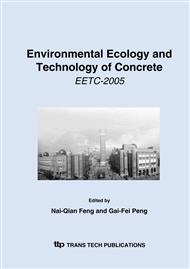p.138
p.150
p.155
p.162
p.167
p.175
p.180
p.184
p.191
Effect of Interfacial Transition Zone on Chloride Diffusion Coefficient
Abstract:
A three-phase composite circle model is presented in this paper to assess the effect of interfacial transition zone (ITZ) on the chloride diffusion coefficient of concrete. Firstly, the distribution of circular aggregate particles was simulated in a square concrete element. Based on the simulated concrete mesostructure, the Monte Carlo algorithm was adopted to numerically evaluate the ITZ area fraction for different concrete mixes. A parametric study was then conducted to quantify the effects of the largest aggregate diameter, ITZ thickness and aggregate gradation on the ITZ area fraction. Secondly, the ITZ was modeled as a thin-wall annular plate located between a circular aggregate particle and a thick-wall cement paste annular plate. With the three-phase composite circle model, an analytical solution was derived for the chloride diffusion coefficient of concrete. Finally, the derived solution was verified by experimental results obtained from the research literature and a quantitative relationship between the thickness and chloride diffusion coefficient of ITZ was established.
Info:
Periodical:
Pages:
167-174
Citation:
Online since:
January 2006
Authors:
Price:
Сopyright:
© 2006 Trans Tech Publications Ltd. All Rights Reserved
Share:
Citation:


